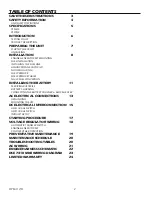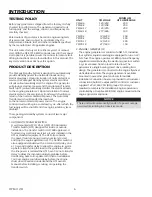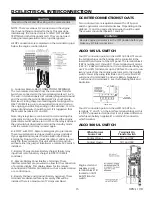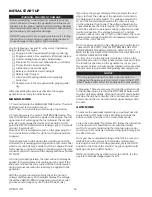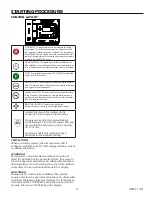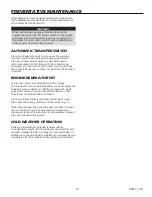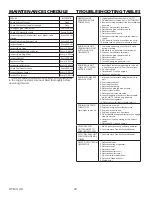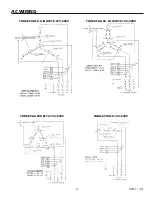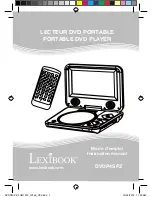
16
OPM-117/D
INITIAL START UP
WARNING: EQUIPMENT DAMAGE:
Before attempting to start this unit, complete your pre-
start checklist and ensure the generator mainline circuit
breaker is in the proper position prior to starting. Starting
this unit without it properly connected can cause serious
personal injury or equipment damage.
DO NOT jump start these engine-generator sets. Starting
these units on a low battery or jump starting them will
cause damage to the engine control module.
Use the following check list to verify correct installation
before starting the engine.
□
Engine oil. Fill as required with proper grade/qty.
□
Engine coolant. Fill as required with proper mixture.
□
Unit mounting base properly bolted down.
□
Clearance for service and maintenance on all sides.
□
Proper fuel line material and size.
□
All fuel line connections tight.
□
Battery connections clean and tight
□
Battery fully charged.
□
All AC and DC wiring installed and properly
protected.
□
Compressor oil. Fill as required with proper grade/
qty.
After completing the previous checklist, the engine-
generator set is ready for initial start-up.
MANUAL MODE
1. Press and release the MANUAL MODE button. The small
LED light next to it should come on.
Note: There is no start delay in this mode of operation.
2. Press and release the green START ENGINE button. The
DSE 7310 MKII will send two signals to the engine. The first
signal wire #21 will engage the fuel solenoid, the second
wire, #22, will engage the starter on the engine. At this
point the DSE7310 will start the cranking cycle (10 seconds
on and 10 seconds off).
Note: Wire #93 is energized to turn on the glow plugs for
15 seconds first and then the starter and fuel solenoid are
engaged.
If the engine fails to start during this cranking period, the
starter motor is disengaged and goes into a rest mode after
which a second attempt is made to start the engine. Should
this sequence continue through 3 cranking cycles the start
sequence will be stopped and the display will show ‘FAILED
TO START”.
3. During manual operation, the load will not normally be
applied to the generator. But caution must be used, if the
line power should fail or be turned off the transfer switch
during manual operation the load may be applied to the
generator.
With the engine running smoothly check the no load
voltage and frequency on the digital display. The voltage
should be 208/240/480 AC depending on which model
you have and a frequency of 59.5 to 60.5 hertz (Hz).
If you have the proper voltage at the generator the next
step is to check the voltage at the generator terminals in
the Automatic Transfer Switch. The voltage between the
G1 and the G3 terminals should be the same as it was
on the generator front panel. The voltage should also be
checked between the hot terminals (G1 and G3) and the
G-N to be certain of a balanced voltage output and a solid
neutral connection. The voltage between G1 and G-N
should be about 120 volts AC (277 on 480 units). The same
approximate voltage should be found between terminals
G3 and G-N (120 volts AC).
On three phase panels the G2 voltage level should also be
checked. ON 240 VOLT (DELTA) SYSTEMS BE SURE YOU
KNOW WHERE THE HIGH VOLTAGE “WILD” LEG IS. IT
MUST BE IN THE SAME LOCATION ON THE LINE SIDE AS IT
IS ON THE GENERATOR SIDE.
(i.e. if it’s on L-3 on the line side it must be on G-3 on the
generator side. Also on three phase systems make sure that
the rotation is the same on the generator as it is on your
line power. Failure to insure proper rotation will cause three
phase motors to spin backwards possibly damaging them.
NOTICE:
If for any reason during the check out procedure the
voltage and frequency are not correct, depress the STOP/
RESET button and correct the trouble before proceeding.
4. Stopping - There are two ways to stop the unit when it is
in the manual mode. Pressing the STOP/RESET button will
stop the unit immediately. Pressing the AUTO mode button
will stop the unit but only after the cool down timers have
timed out and there is no remote start signal being sent to
the unit.
AUTO MODE
To activate the automatic start mode you will just need to
depress the AUTO button, the LED indicator beside the
button confirms that the unit is in automatic mode.
To test the Automatic Transfer Switch, follow the instruction
on the operator’s manual that came with the transfer
switch. If you get a fault during the initial start up or prior
to start up, it is most likely a false warning light. Simply reset
the ATS start over.
Once you have completed testing of the ATS, be sure you
ALWAYS leave the system in the standby mode,unless
servicing the unit. For standby operation, press the AUTO
button on the front of the control. The green light should
light up next to the AUTO button.
NOTE: For setting the exerciser circuit, for all ATS, see the
operator’s manual shipped with the ATS.

